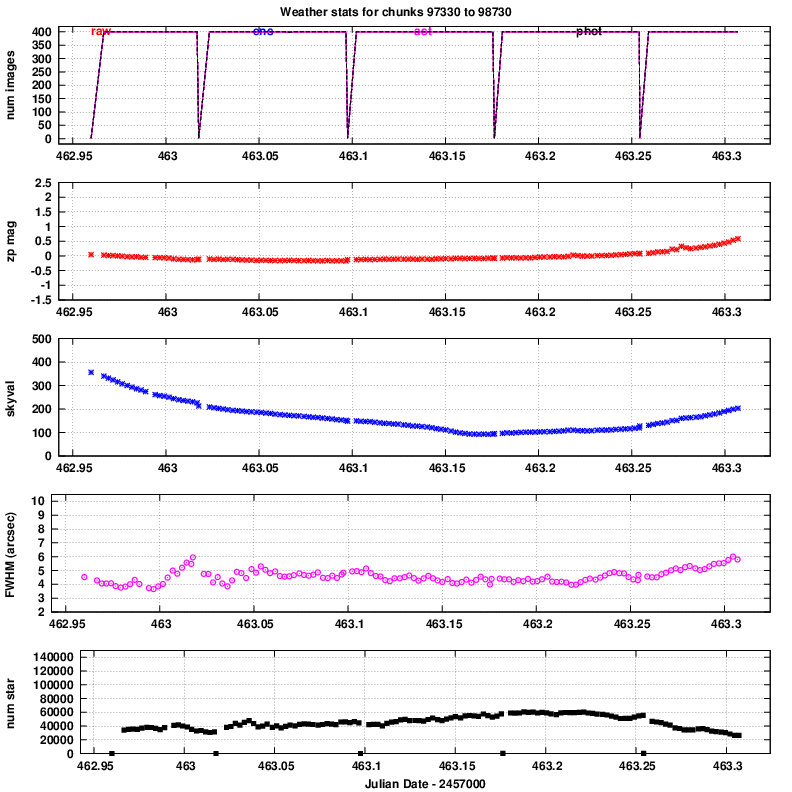
Please read Tech Note 008 for details on some steps below, as the search method was the same.
I followed the methods described in earlier Tech Notes to process the data, starting with the raw "composite" FITS files, and ending with calibrated lists of stars. Using the machine pmdata, it takes very roughly 24 hours to process completely one night's data from 8 chips.
Once the data has been processed into the calibrated star lists and other files, it can be searched for transients within about 10 minutes; it takes another 10-20 minutes to check the resulting candidates by eye. I have written scripts to facilitate all these steps, including (as you will see in links below) creating tables with the properties and images of each candidate.
Please remember that the methods I am using explicitly will NOT detect single-frame events. In order to find such very brief flashes, one would have to write a new piece of software which would start with the calibrated starlists from each individual image and look through them. I have not done that yet.
In order to place limits on the rate of transient objects, one needs to know the combination of area and time covered by a search. I have chosen to use the units:
"control time" = (area in square degrees) * (time in seconds)
Thus, an area of 1 square degree, monitored continuously for one hour, would yield a "control time" of 3600 sq.deg.*sec.
A critical factor in these calculations is the limiting faintness, which describes the faintest object which could have been discovered. In the case of a brief transient, this is better described as a fluence, rather than as the typical flux limit. Fluence is simply the integral of flux over time; it can be expressed as energy received within a certain area, or as the number of photons detected within a certain area.
In the case of this Tomoe data, each image has an exposure time of 0.5 seconds, and my search parameters required that an object appear in at least 3 images. Thus, the minimum fluence an object must have can be calculated as follows:
In other words,
Fluence limit F(min) = f * (exptime) * (min_det)
where
-0.4*m ( -6 )
f = 10 * ( 3.16 x 10 erg/cm.sq.-sec )
( )
The second term in the lower equation is the zeropoint of the V-band magnitude scale: the flux corresponding to a star of magnitude V=0.
How to determine the limiting magnitude of each image? I used a single value for all the images in a single chunk (360 images over 3 minutes), defining it using the magnitude at which stars were detected in 50% of the images; see Tech Note 4 for examples.
Now, it is easy to see very bright transients: they will appear even if there are light clouds. But faint transients will be detected only when conditions are very good. We can therefore expect quite different "control times" for different choices of minimum Fluence.
For ease of discussion, I chose 4 minimum Fluence values, corresponding to the Fluence provided by stars of various magnitudes during a 1-second exposure. It will be useful to use this term when comparing to other searches, which will typically quote a magnitude limit during one of their own much longer exposures.
Here are the total control times for these choices of limiting Fluence.
Summed "control times",
in units of (square degrees * seconds)
limiting mag in a 1-second exposure
Night V=13 V=14 V=15 V=16
-----------------------------------------------------
20160315 49,357 49,357 49,357 43,685
20160316 40,520 40,520 38,834 33,083
20160317 43,984 43,741 41,077 32,671
20160330 30,133 29,292 25,108 19,253
20160408 33,068 31,919 28,311 23,028 (*) bad chunk
20160409 30,015 29,298 25,848 10,807
20160411 36,771 34,252 28,888 14,843
20160414 28,216 25,715 20,015 128
total 292,069 284,100 257,441 177,502
-----------------------------------------------------
(*) On the night of 20160408, one set of chunks, number 010727x, contained bogus data in most of the images; some rectangular blocks of pixel data looked like real sky, but other rectangular blocks were black or empty. The method I used to search for bad data did not disqualify the chunks, so they were originally included in the transient search, creating hundreds of false candidates, and adding to the control time for the night. I removed all candidates from the bad chunks, leaving 7 good candidates; I multiplied the control times by 0.94, since this one time period represented 8/151 of all the otherwise good chunks.
Note that the total control time combined for these eight nights, with 8 chips, is close to a single square degree, monitored continuously for 3*24 hours (which would be 259,200 sq.deg-sec).
Below are animated GIFs showing the overall properties of each night. The figures cycle through the measurements from all 8 chips, and repeat endlessly.
The night of 20160315 was a good one. The sky was a bit bright early, but otherwise, very good conditions.

The night of 20160316 had high sky values at the start, and perhaps brief clouds, but was otherwise pretty good.
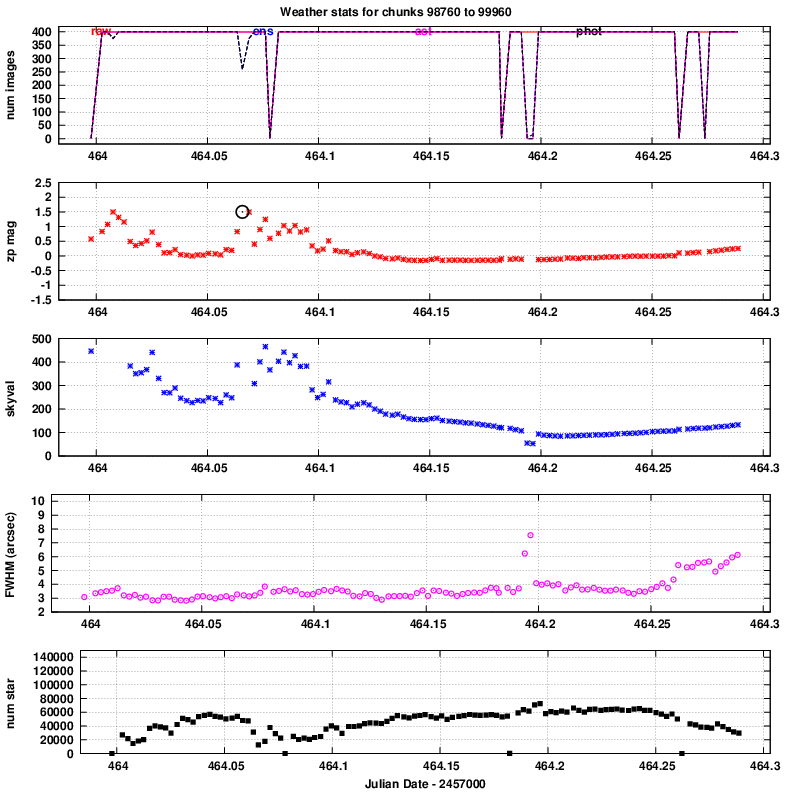
The night of 20160317 had very high sky values in the first half, and a short period of clouds. Much of the data for chip 7 failed to process normally.
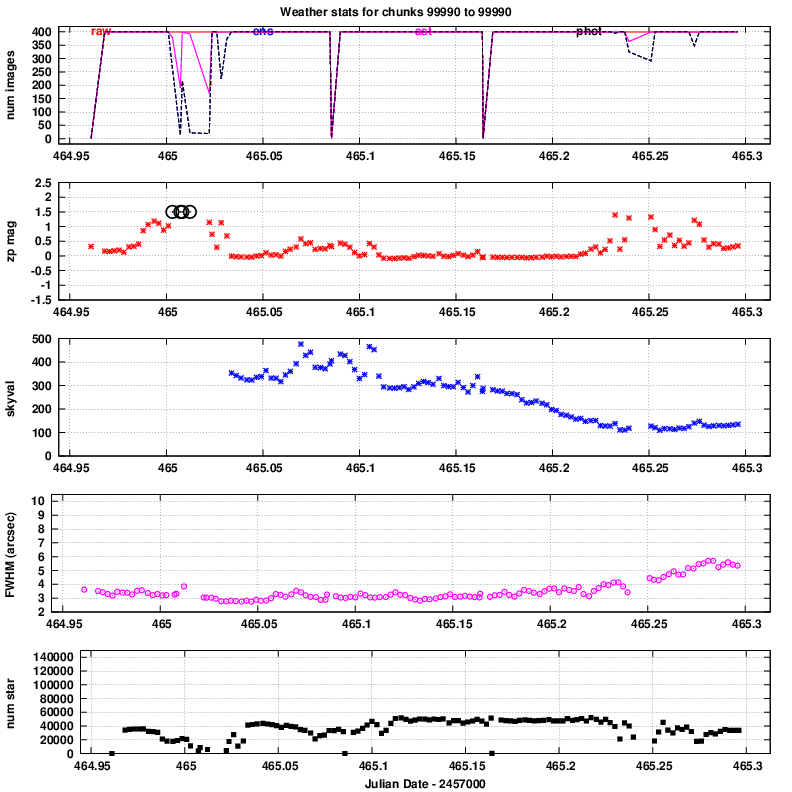
The night of 20160330 was short, and conditions (sky brightness and seeing) turned bad in the second half.
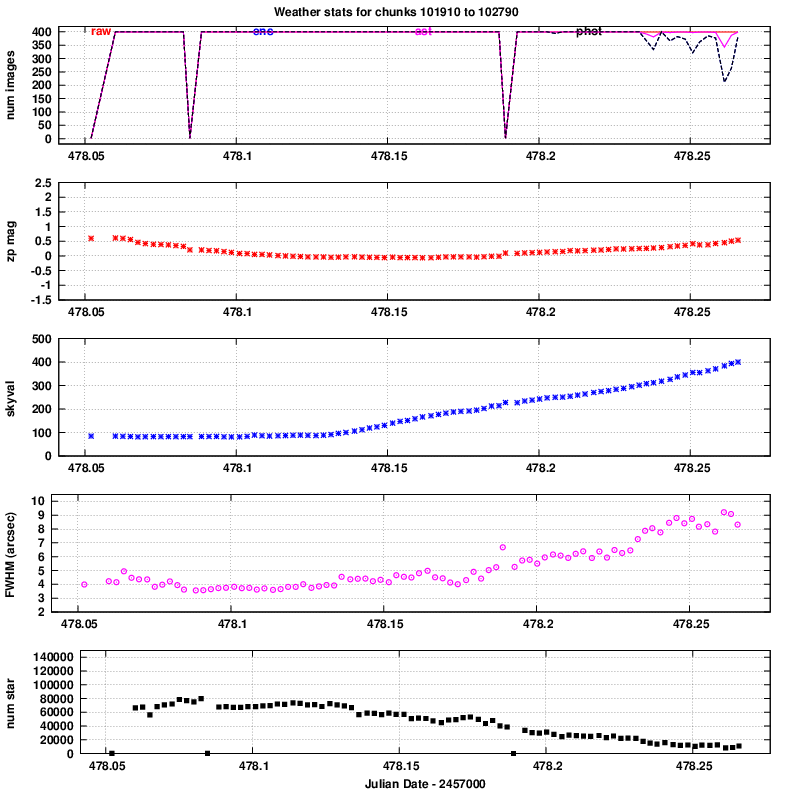
The night of 20160330 was short, and conditions (sky brightness and seeing) turned bad in the second half.

The night of 20160408 was a good one.
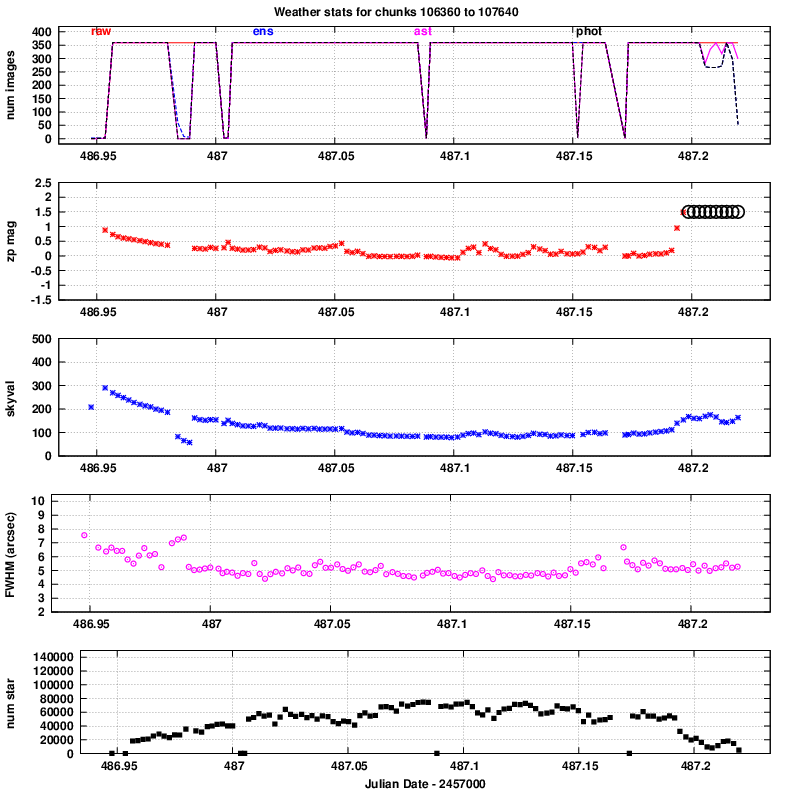
The night of 20160409 wasn't bad, but suffered from some light clouds.
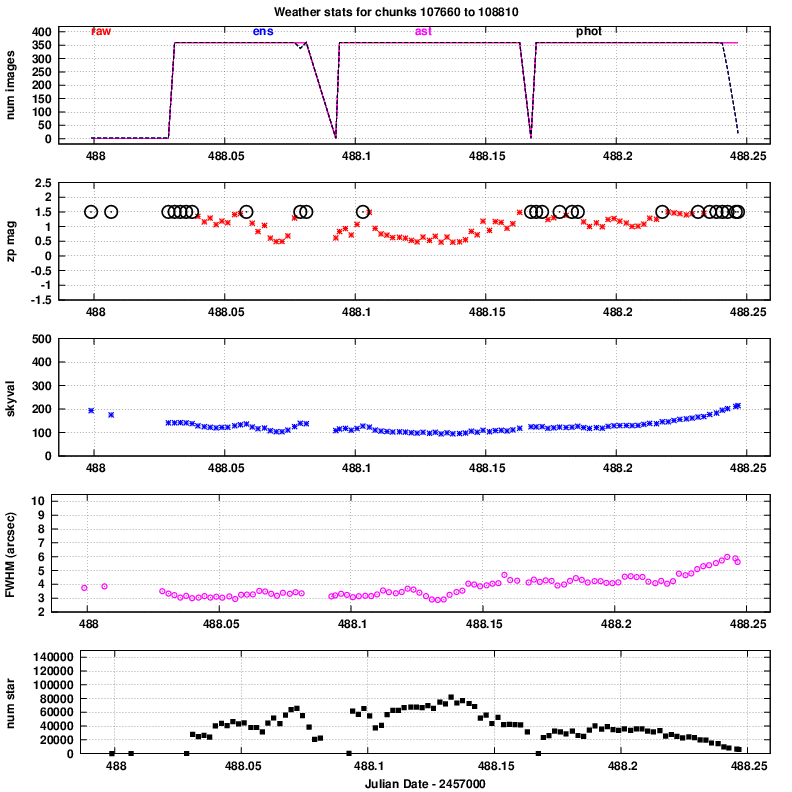
The night of 20160411 was pretty good: the seeing wasn't very good at the start and end, but most of the night was nice.
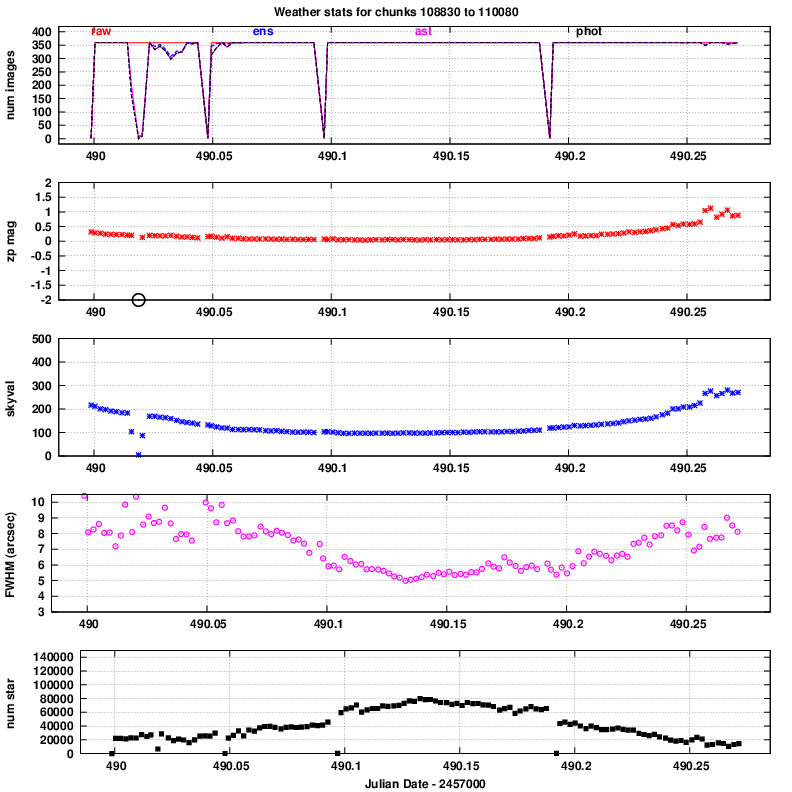
The night of 20160414 was not as nice. Clouds were present in the middle of the night, so few stars were measured during that time.
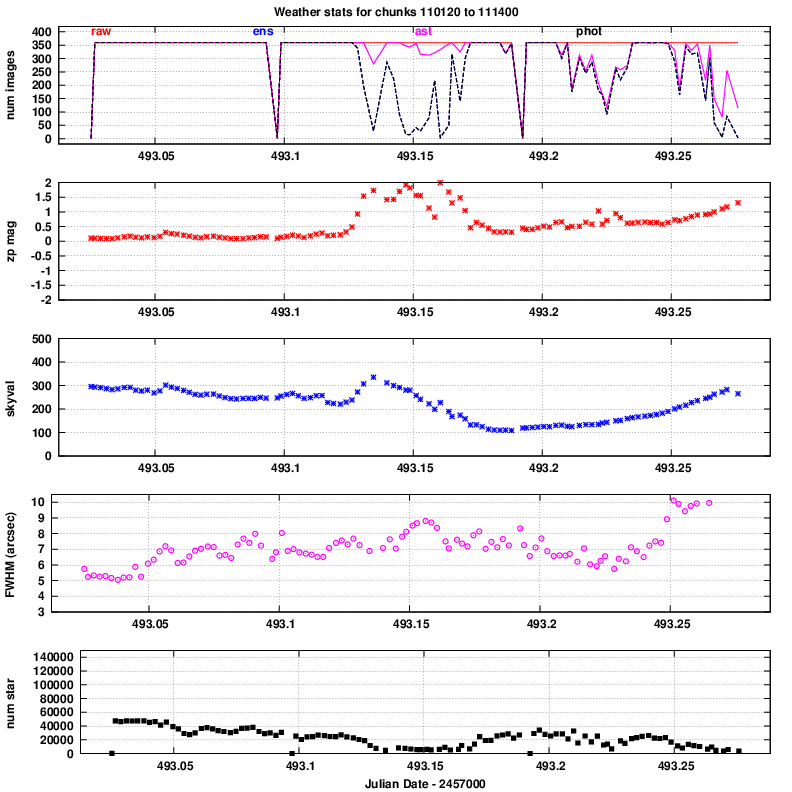
You can find tables listing the candidates for each night, with numerical values of RA, Dec, mag, etc., and pictures of the objects, at the following links. Each candidate has little pictures of it showing the image before it was detected, all the images in which it was detected, and finally the image after it was detected. So, a transient found in 4 images will have 6 pictures: (1 before, 4 detections, 1 after).
Here are the parameters used to select these candidates:
Using these parameters, I found
night candidates notes ------------------------------------------------------- 20160315 3 20160316 2 20160317 7 moving object (see note below) 20160330 2 20160408 7 after discarding chunks 010727x 20160409 16 20160411 4 20160414 16 -------------------------------------------------------
I inspected all the candidates by eye. Most of them were real, faint stars, present in Digitized Sky Survey images and big catalogs. A few were relatively bright stars which, in bad seeing, were occasionally detected at a large enough offset from their usual position that the software counted it as a "new star."
On the night of 20160317, 2 of the candidate transient objects were created by a single moving object. It moved from west to east at a speed of very roughly 5 arcsec per second, which puts it somewhere around geosynchronous orbit. Over a short path, the motion had components 0.9 arcsec/sec south, 4.9 arcsec/sec east. It was detected in chunk 0100971 at roughly mag 17.9, as an "object" in frames 110-112, and then again as a different "object" in frames 117-119.
The fact that this object did appear in the list of candidates, and that I noticed it as NOT an ordinary, constant star when comparing it to the Digitized Sky Survey, is an indication that my methods to find transients are working -- to some degree.